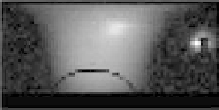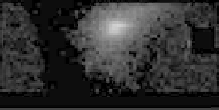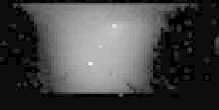Graphics Reference
In-Depth Information
(a) (b) (c)
Figure 8.31
Separation of the diffuse and specular components in a reflectance function. (a) Reflectance
function.
(b) Specular component.
(c) Diffuse component.
(From [Debevec et al. 00]
c
2000 ACM, Inc. Included here by permission.)
viewpoint and each spotlight. So the authors employ a different approach based
on the simplifying assumption that the diffuse reflection has the color of the sur-
face, while the specular reflection has the color of the light. This is a reasonable
assumption for human skin, as it is basically a dielectric material—as noted pre-
viously, specular reflection from a dielectric usually does not capture the color of
the underlying surface. Each pixel can be roughly separated into a diffuse and
specular component based on this assumption. Figure 8.31 illustrates this sep-
aration: as the light color is white, the reflectance function
(
Figure 8.31(a)
)
is
first separated into the white specular component (
Figure 8.31 (b)
)
and the diffuse
component, which contains the skin chromaticity (
Figure 8.31 (c)
)
.
Based on the preliminary separation, the surface normal direction at the sur-
face point
(
,
)
can be estimated from the diffuse component: the light direction
is known, so the normal comes from fitting to a Lambertian “lobe.” The two color
parameters
u
v
α
1
from Equation (8.9), which defines the modified diffuse
component, are fit using the approximate surface normal. From these parameters,
the diffuse component is separated again, this time more precisely, and the surface
normal is computed again from this more precise diffuse component.
From the separate diffuse and specular BRDF components, the surface nor-
mal, and the skin reflectance model, the reflectance field value
R
can be synthe-
sized for an arbitrary view direction. The diffuse and specular components are
constructed separately; the diffuse component comes from Equation (8.9). The
specular component is more difficult to compute. The process works by factoring
the Torrance-SparrowBRDF model into a product of the separate Fresnel term
F
,
the geometry term
G
, and microfacet distribution. The first two,
F
and
G
, can be
computed analytically. As the Torrance-Sparrow model depends on the product
of all three terms, the distribution term can be estimated from the ratio of specular
reflectance values of two specular reflectance functions.
The reflectance function for an arbitrary viewing direction is synthesized by
separately synthesizing the diffuse and specular reflection functions, and adding
α
0
and










